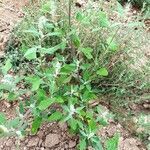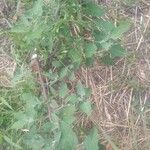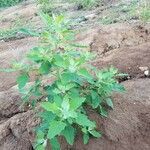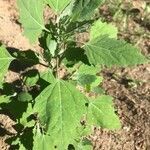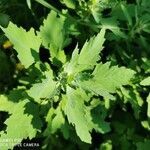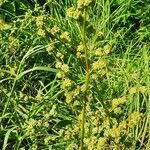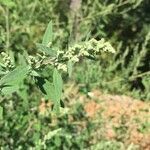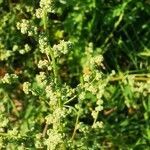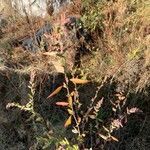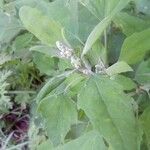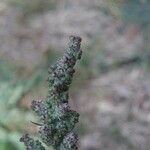Erect annual, much branched and to 1 m when well developed, the stems only seldom pigmented at the nodes, the lvs and infl often turning reddish late in the season; lvs generally ± white-mealy, rhombic-ovate to lanceolate, 3–10 cm, broadly cuneate at base, the larger (lower) ones mostly 1.5–2+ times as long as wide and almost always toothed; fls in dense glomerules, forming interrupted or continuous spikes that are grouped into a terminal paniculiform infl; cal ± white-mealy, its segments ± strongly carinate or cucullate, covering the fr, or sometimes looser and exposing the fr; style divided to the base, wholly deciduous; pericarp very thin and delicate, closely adherent to the seed and usually scarcely separable from it, smooth or only obscurely roughened when viewed at 10× or even 20×, uniformly black or blackish; seeds horizontal, black, shining, mostly 1.0–1.5 mm wide, usually marked with a faint radial furrow, otherwise smooth or nearly so; 2n=54. June–Oct. Polymorphic European weed, now widely intr. in N. Amer. and elsewhere. Sometimes divided into an indefinite number of infraspecific taxa or specific segregates. (C. glaucophyllum; C. lanceolatum, a relatively narrow-lvd form) In our range the two following segregates are particularly noteworthy and probably merit some sort of taxonomic recognition.
Erect annual, often much branched, not markedly smelling, without any yellow glands, 15 cm-1½ m high; all vegetative parts and outside of perianth, when young, densely clothed with white or partly amaranthine powdery vesicles, otherwise glabrous; the amaranthine vesicles soon turning white; all old vesicles shrivelling up and losing their colour. Stem angular, ribbed, with longitudinal dark green or red streaks. Lower leaves long-petioled, ovate-rhomboid, irregularly and rather coarsely dentate-serrate-laciniate or deeply gashed; higher ones gradually shorter-petioled, elliptic-oblong-lanceolate from an acute or contracted base, acute or obtuse, less deeply incised or entire; all leaves herbaceous, 1½-15 by ½-13 cm. Flowers in panicled clusters, 5-merous, ☿; panicles often collected in a large terminal leafy paniculate inflorescence. Perianth herbaceous, not becoming fleshy after anthesis. Tepals distinctly connate at the base, oval, very concave, obtuse, with a strong, rounded midrib, 1½-1½ mm long. Stamens slightly longer than the perianth. Ovary depressed globose; stigmas 2, short. Fruit in the living plant entirely enclosed by the incurved tepals, depressed-globose, finely papillate. Seed horizontal, lenticular, surrounded by an obtuse keel, shining blackish brown, smooth or nearly so,1¼-1¾ mm diam.
Erect or spreading, simple or branched, green or grey-farinose, sometimes reddish tinged, eglandular, non-aromatic, annual herb. Stems (2)-5-200 cm tall. Petiole usually 1-1.5× lamina; lamina extremely variable, usually 1.5-7 × 1-4 cm, lanceolate to ovate, rhombic or triangular, entire to coarsely serrate-dentate, rarely slightly 3-lobed; base usually cuneate, sometimes rounded or truncate; farina when present denser beneath, sometimes purple-tinged on young lvs, very rarely lamina bright green. Infls paniculate, sometimes very narrow, terminal and axillary, to c. 30 cm long, lacking subtending lvs in upper part, simple in depauperate plants, otherwise spicately branched; glomerules c. 8-flowered, dense or interrupted, ± farinose. Fls usually in dense panicles, sessile or subsessile. Perianth segments 0.5-2.5-(3) × 0.6-1 mm, broad and imbricate, accrescent; keel obtuse, green; margins broadly hyaline. Fr. completely invested by perianth; pericarp easily removed. Seed horizontal, (1.0)-1.1-1.4-(1.6) mm diam., flattened, circular, glossy black, generally smooth except for faint striations; keel obtuse.
Stems erect to sprawling, simple to much-branched, 1-30 dm, sparsely to densely farinose. Leaves nonaromatic; petiole 1-2.5 cm, shorter than blades or occasionally longer; blade ovate-lanceolate to rhombic-lanceolate or broadly oblong, 1-5.5(-12) × 0.5-3.8(-8) cm, base narrowly to broadly cuneate, margins sinuous-dentate to shallowly serrate or entire, apex acute to subobtuse, farinose abaxially. Inflorescences glomerules or occasionally 1-flowered peduncles in terminal and lateral compound spikes, 2-19 cm; glomerules subglobose, 3-4 mm diam.; bracts absent. Flowers: perianth segments 5, distinct nearly to base; lobes ovate, ca. 1 × 1.1 mm, apex obtuse, keeled, farinose, largely covering fruit at maturity; stamens 5; stigmas 2, 0.2-0.3 mm. Utricles depressed-ovoid; pericarp nonadherent, occasionally adherent, smooth to papillate. Seeds lenticular, margins round, 0.9-1.6 mm diam.; seed coat black, smooth, indistinctly granulate and/or radially grooved, or with faint reticulate-rugose ridges. 2n = 54.
Herbs annual, 15-150 cm tall. Stem erect, much branched, green or purple-red striate, stout, ribbed; branches oblique or spreading. Leaf blade rhombic-ovate to broadly lanceolate, 3-6 × 2.5-5 cm, 1-2 × as long as petiole, abaxially ± farinose, adaxially usually glabrous, or sometimes reddish purple vesicular hairy on young leaves, base cuneate to broadly so, margin irregularly serrate, apex subobtuse or acute. Glomerules arranged into large or small panicles or spikelike panicles on upper part of branches. Flowers bisexual. Perianth segments 5, broadly ovate to elliptic, abaxially longitudinally keeled, farinose, margin membranous, apex acute or slightly emarginate. Stamens 5; anthers exserted. Stigmas 2. Pericarp adnate to seed. Seed horizontal, black, sublustrous, lenticular, 1-1.5 mm in diam., lineate, rim margin obtuse. Fl. and fr. May-Oct.
An annual plant. It grows to 1 m high and spreads to 1 m across. The stem is erect. The stems are succulent and without hairs. They often have soft mealy lumps which can be rubbed off. The leaves are simple, with one at each node, and occurring alternately up the stem. The leaves are oval and wedge shaped with saw like edges. They are 5-12 cm long by 3-10 cm wide. The leaf stalk is usually shorter than the leaf blade. The under surface of the leaf often has a white mealy layer which can be rubbed off. The flowers occur in dense white spikes. The flowers occur at the tip and ends of branches. The fruit is a pod. It is small and roundish and papery. It opens around the tip. The pod contains a shiny black seed. Seed are 1.2-1.8 mm across. Seeds can occur in very large numbers.
Erect annual c. 1 m high, mealy especially on flowers and undersurface of leaves. Leaves thin; lower leaves petiolate, ovate-rhombic, cuneate at base and variously dentate, the lamina 2–4 cm long; upper leaves narrowly ovate to lanceolate, entire, ± sessile. Inflorescence ± leafless, of glomerules aggregated into a large panicle. Flowers bisexual or female. Tepals 5 united in lower half, weakly keeled (terminal ones larger and more strongly keeled), green, mealy. Stamens 5, glabrous; disc absent. Pericarp membranous, readily detached. Seed horizontal, lenticular, c. 1.2 mm diam., bluntly keeled; testa smooth, glossy, striate or weakly furrowed, black. Seed shed within surrounding perianth.
Leaves very variable even on a single plant, rhombic-ovate to lanceolate, usually distinctly longer than broad by at least 14 times (but the juvenile leaves following the cotyledons may be almost as broad as long), 1.2–8.2 × 0.3–5.5 cm.; leaf-margins entire or more commonly with up to about 10 shallow irregular teeth on each side, the lowermost tooth or lobe on each margin sometimes more prominent than the rest; apex of each margin sometimes more prominent than the rest; apex of leaf acute, or particularly in the lower cauline leaves subacute to rounded; superior leaves and bracts progressively smaller.
Annual herb, 0.1-1.0 m high, much branched, green, stem often red or pinkish striped, young parts covered by grey-mealy hairs. Leaves variable, rhombic-ovate to lanceolate, 12-82 x 3-55 mm, margins with up to 10 shallow, irregular teeth on both sides, apex acute. Inflorescences of ample panicles of many, rounded clusters, with minute, grey to green flowers. Pericarp somewhat persistent. Seeds black, shiny.
Annual herb, up to 1 m high. Stems erect or drooping, ribbed. Leaves petiolate; blade ovate, narrowly ovate to subtrilobed, variable in size, margins entire, toothed or lobed, upper surface dark green, lower surface with a thick whitish, mealy covering; petioles slender, up to 40 mm long. Flowers: in dense, leafless, terminal panicles, overtopping leaves; perianth green; Dec.-Apr.
Annual herb usually 10–150 cm. high, normally, much branched, but sometimes stems simple or subsimple especially in small plants; plant green or tinged red especially on stem (which is often red or pink striped), more or less clothed with grey-mealy hairs especially on young parts.
Inflorescence a usually ample pancile of very numerous small or medium-sized (2–6 mm. in diam.) densely or laxly spicately or cymosely arranged dense rounded clusters (“glomerules”) of minute grey to green flowers, the latter 1–1.5 mm. in diam.
Pericarp somewhat persistent, but easily rubbed or scraped off seed. Seeds black, shining, 1.2–1.6 (1.85) mm. in diam., bluntly keeled; testa (see under microscope) marked with faint irregular radial furrows, but otherwise almost smooth.
Erect annual herb, up to 1.5 m high. Leaves lanceolate-ovate to subtrilobed; petioles slender, up to 40 mm long. Flowers in dense leafless terminal panicles, overtopping leaves. Flowers green.
Perianth segments 5, papillose with grey mealy hairs on margins and outside, each with a prominent green keel in upper part.
Stamens 5.
